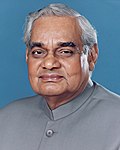
Back ২০০৪ৰ ভাৰতৰ সাধাৰণ নিৰ্বাচন Assamese ভারতের সাধারণ নির্বাচন, ২০০৪ Bengali/Bangla Parlamentswahl in Indien 2004 German Elecciones generales de India de 2004 Spanish Élections législatives indiennes de 2004 French הבחירות ללוק סבהה (2004) HE भारतीय आम चुनाव, २००४ Hindi 2004年インド総選挙 Japanese 2004-ലെ ഇന്ത്യയിലെ പൊതുതെരഞ്ഞെടുപ്പ് Malayalam २००४ लोकसभा निवडणुका Marathi
| |||||||||||||||||||||||||||||||||||||||||||||
543 of the 545 seats in the Lok Sabha 272 seats needed for a majority | |||||||||||||||||||||||||||||||||||||||||||||
|---|---|---|---|---|---|---|---|---|---|---|---|---|---|---|---|---|---|---|---|---|---|---|---|---|---|---|---|---|---|---|---|---|---|---|---|---|---|---|---|---|---|---|---|---|---|
| Registered | 671,487,930 | ||||||||||||||||||||||||||||||||||||||||||||
| Turnout | 58.07% ( | ||||||||||||||||||||||||||||||||||||||||||||
| |||||||||||||||||||||||||||||||||||||||||||||
 Results by constituency | |||||||||||||||||||||||||||||||||||||||||||||
| |||||||||||||||||||||||||||||||||||||||||||||
General elections were held in India in four phases between 20 April and 10 May 2004. Over 670 million people were eligible to vote, electing 543 members of the 14th Lok Sabha.[1] Seven states also held assembly elections to elect state governments. They were the first elections fully carried out with electronic voting machines.
On 13 May the Bharatiya Janata Party (BJP), the lead party of the National Democratic Alliance conceded defeat.[2] The Indian National Congress, which had governed India for all but five years from independence until 1996, returned to power after a record eight years out of office. It was able to put together a comfortable majority of more than 335 members out of 543 with the help of its allies. The 335 members included both the Congress-led United Progressive Alliance, the governing coalition formed after the election, external support from the Bahujan Samaj Party (BSP), Samajwadi Party (SP), Kerala Congress (KC) and the Left Front.
After facing criticism from her own party and from the country, Congress President Sonia Gandhi asked the 22nd Finance Minister Manmohan Singh, an economist, to head the new government. Singh had previously served in the Congress government of Prime Minister P. V. Narasimha Rao in the early 1990s, when he was seen as one of the architects of India's first economic liberalisation plan, which staved off an impending monetary crisis. Despite the fact that Singh had never won a Lok Sabha seat, his considerable goodwill and Sonia Gandhi's nomination won him the support of the UPA allies and the Left Front. Manmohan Singh became the first Sikh and non-Hindu prime minister of India.
- ^ "General Elections 2004: Facts and figures". India Today. Archived from the original on 23 July 2023. Retrieved 23 July 2023.
- ^ Waldman, Amy (13 May 2004). "In Huge Upset, Gandhi's Party Wins Election in India (Published 2004)". The New York Times. Archived from the original on 18 August 2018. Retrieved 22 August 2023.


